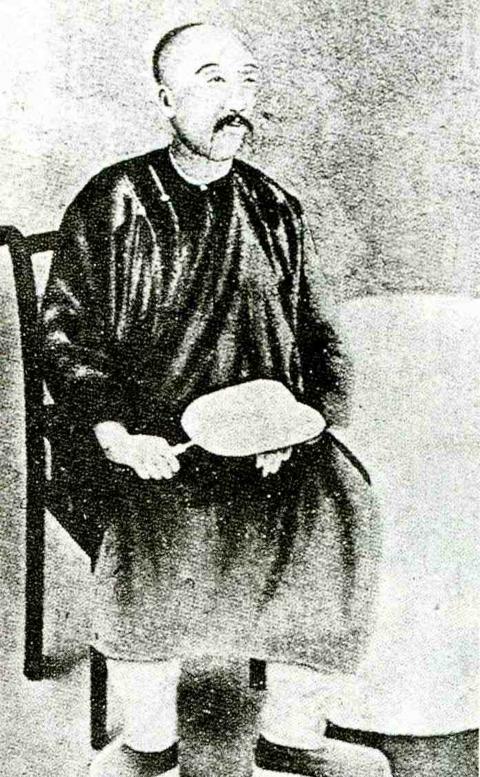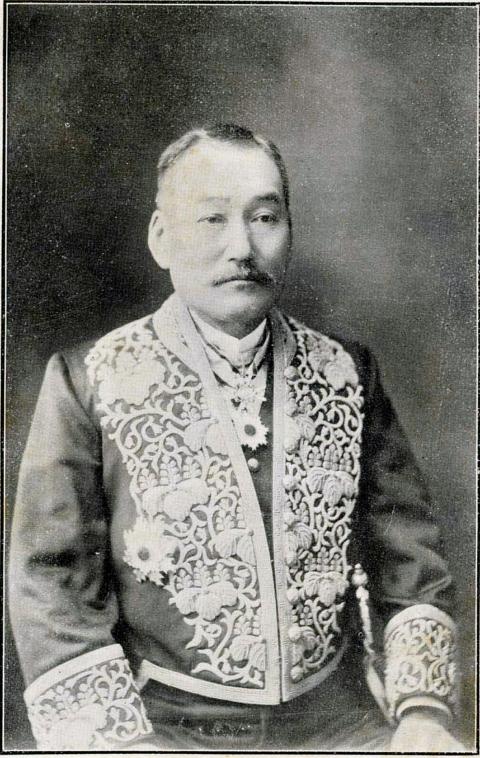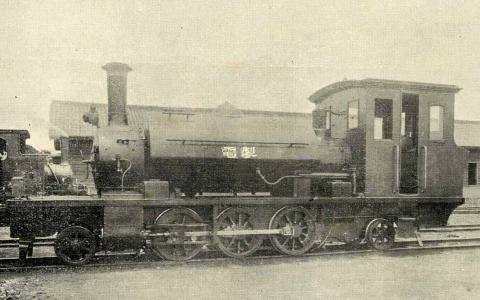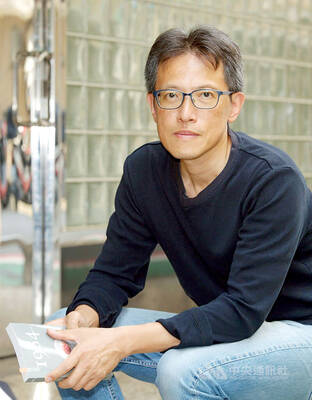Aug. 14 to Aug. 20
On Aug. 15, 1978, the first Tzechiang-class express train (自強號) made its official maiden voyage, traversing the newly electrified route between Taipei and Taichung. It was a British EMU100 train, a model that was used by the Taiwan Railway Company until June 2009.
It was a major milestone in Taiwan’s railroad history, which stretches back to the construction of the first railroad in 1887 under the supervision of the Qing Empire’s governor of Taiwan, Liu Ming-chuan (劉銘傳). Liu is often considered the “father of Taiwan’s railways,” but a quick Google search will reveal that there is another contender for the title — Japanese national Hasegawa Kinsuke, who was the chief engineer behind the completion of the Taiwan Trunk Line (縱貫線) in 1908, which connected Kirun (Keelung) and Takao (Kaohsiung).

Photo courtesy of Wikimedia Commons
Liu was Taiwan’s first governor when the Qing decided to separate it from Fujian Province in 1885. Long considered a backwater province, the Qing only began to take an interest in developing Taiwan in the latter half of the 19th century.
The idea of building a railroad in Taiwan was first proposed in 1877 by Fujian governor Ting Jih-chang (丁日昌), who saw Taiwan as a key defensive location — but it never materialized due to technical and financial issues.
Liu officially submitted a requested to the imperial court in April 1887 to build a north-south railroad. The court approved it a month later. Liu quickly set up the government-run Taiwan Railway Business Administration (全台鐵路商務總局) and recruited British and German engineers. Construction reportedly began June 9, the birthday of George Stephenson, who built the first public railway in the world — some dispute this claim, but the date is still officially observed as the anniversary of Taiwan’s railroad.

Photo courtesy of Wikimedia Commons
The first tunnel, from Taipei to Keelung, took about three years and resulted in many deaths and accidents. Upon its completion, Liu wrote a couplet which ended with “human power triumphs over God’s work” (居然人力勝神工). The first car made a test journey from Dadaocheng (大稻埕) to Xikou (錫口, today’s Songshan District, 松山) area in July 1888, drawing thousands of spectators.
Qing era railway construction ended in Hsinchu in 1894. Liu had left his post three years earlier, and his successor Shao Yu-lien (邵友濂) stopped most of Liu’s modernization programs soon after.
THE JAPANESE EFFORT

Photo courtesy of Wikimedia Commons
A year later, the Qing ceded Taiwan to Japan. Historian Tai Pao-tsun (戴寶村) writes in the book Around the Island: The History of Taiwan’s Railway (縱貫環島:台灣鐵道) that the railroad was already in pretty bad shape when the Japanese took over and the situation was exacerbated when the retreating Qing troops sabotaged the tracks and facilities.
By July 1895, the Japanese had restored the entire railroad to working condition, using it to transport supplies in their campaign south against local resistance. Tai finds it ironic that the railroad, which was built to protect Taiwan, ended up being used by the invaders against the local population.
In the first few years, the Japanese uprooted sections of the old railroad, even abandoning the Taipei-Keelung tunnel and building a new one that was easier to traverse.
In 1899, construction began to extend the railroad further south, employing Japanese engineers and cheap Taiwanese labor. Books on Taiwanese history barely mention Hasegawa, who began his railroad career as a technician in 1877 and arrived in Taiwan in 1899 as the project’s chief engineer.
Shinpei Goto, minister of civilian affairs, wrote later in an official railroad publication, “I was the head of the railway project in name only. In fact, everything related to railroad construction was taken care of by Hasegawa. All I did was stamp paperwork.”
Hasegawa deemed the original Qing Dynasty line too steep and planned a new line south from Taihoku (Taipei). At the same time, he ordered construction to start north from Takao (Kaohsiung). During this time, he also helped build stations, branch lines (such as one to Tamsui) and connections to various ports.
The two construction camps finally met in the middle on April 20, 1908, and Hasegawa left Taiwan shortly after, having completed Liu’s vision 20 years later. A statue of Hasegawa stood in front of then-Taihoku Station from 1910 until the end of Japanese rule.
Taiwan in Time, a column about Taiwan’s history that is published every Sunday, spotlights important or interesting events around the nation that have anniversaries this week.

Last week, the the National Immigration Agency (NIA) told the legislature that more than 10,000 naturalized Taiwanese citizens from the People’s Republic of China (PRC) risked having their citizenship revoked if they failed to provide proof that they had renounced their Chinese household registration within the next three months. Renunciation is required under the Act Governing Relations Between the People of the Taiwan Area and the Mainland Area (臺灣地區與大陸地區人民關係條例), as amended in 2004, though it was only a legal requirement after 2000. Prior to that, it had been only an administrative requirement since the Nationality Act (國籍法) was established in

Three big changes have transformed the landscape of Taiwan’s local patronage factions: Increasing Democratic Progressive Party (DPP) involvement, rising new factions and the Chinese Nationalist Party’s (KMT) significantly weakened control. GREEN FACTIONS It is said that “south of the Zhuoshui River (濁水溪), there is no blue-green divide,” meaning that from Yunlin County south there is no difference between KMT and DPP politicians. This is not always true, but there is more than a grain of truth to it. Traditionally, DPP factions are viewed as national entities, with their primary function to secure plum positions in the party and government. This is not unusual

More than 75 years after the publication of Nineteen Eighty-Four, the Orwellian phrase “Big Brother is watching you” has become so familiar to most of the Taiwanese public that even those who haven’t read the novel recognize it. That phrase has now been given a new look by amateur translator Tsiu Ing-sing (周盈成), who recently completed the first full Taiwanese translation of George Orwell’s dystopian classic. Tsiu — who completed the nearly 160,000-word project in his spare time over four years — said his goal was to “prove it possible” that foreign literature could be rendered in Taiwanese. The translation is part of

The other day, a friend decided to playfully name our individual roles within the group: planner, emotional support, and so on. I was the fault-finder — or, as she put it, “the grumpy teenager” — who points out problems, but doesn’t suggest alternatives. She was only kidding around, but she struck at an insecurity I have: that I’m unacceptably, intolerably negative. My first instinct is to stress-test ideas for potential flaws. This critical tendency serves me well professionally, and feels true to who I am. If I don’t enjoy a film, for example, I don’t swallow my opinion. But I sometimes worry